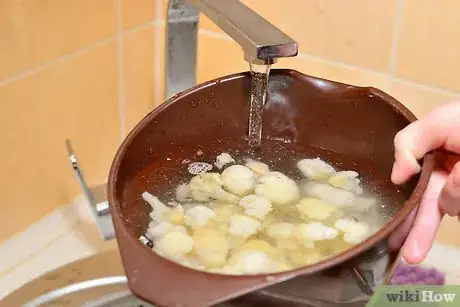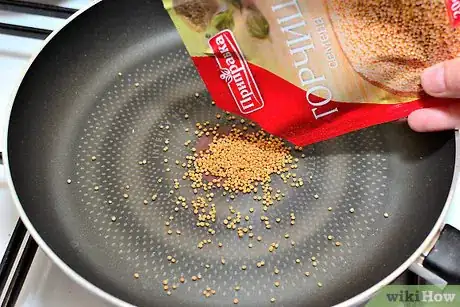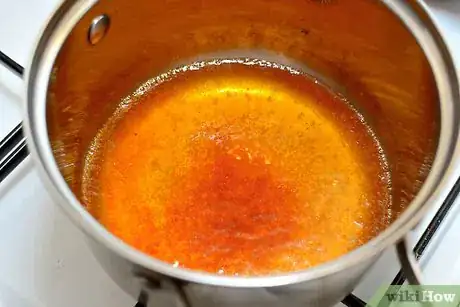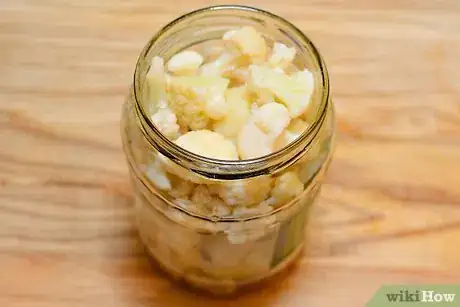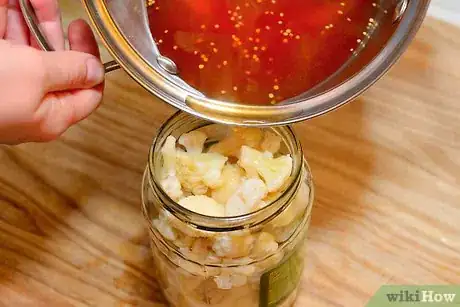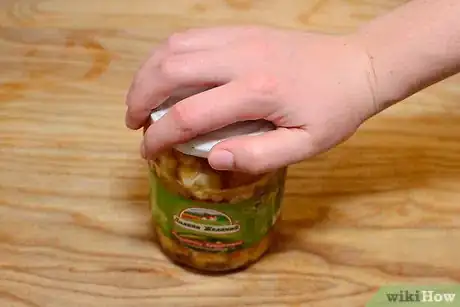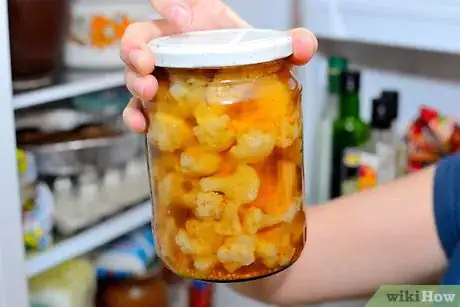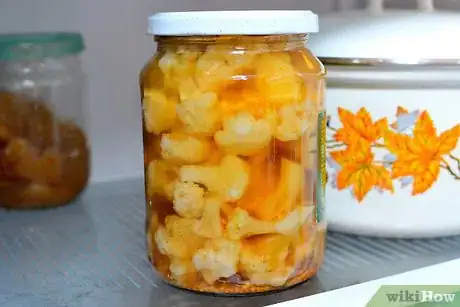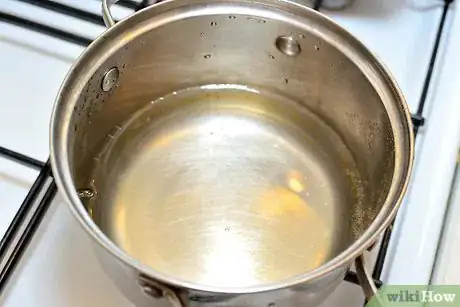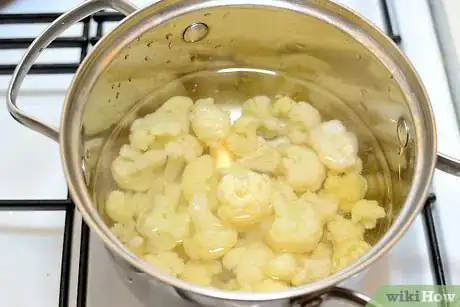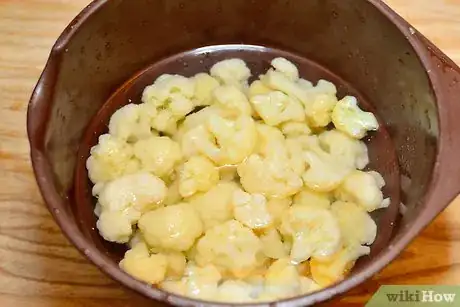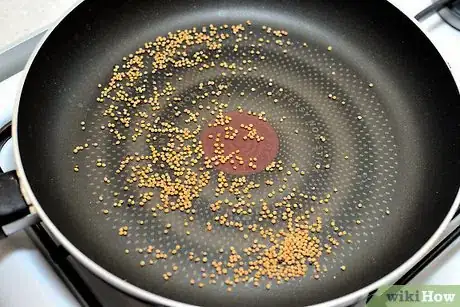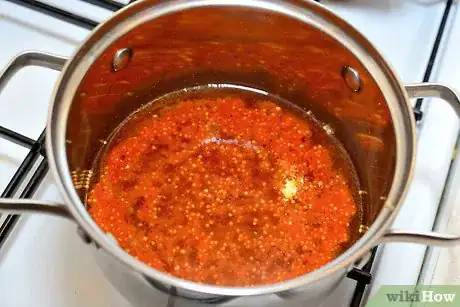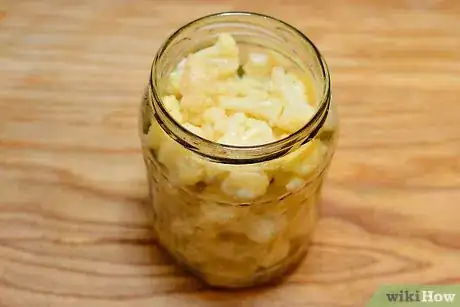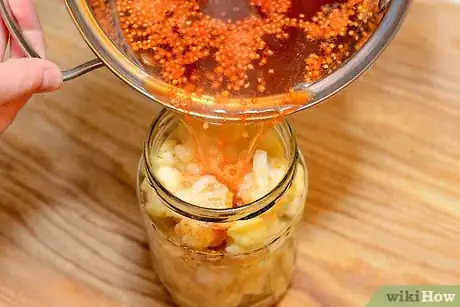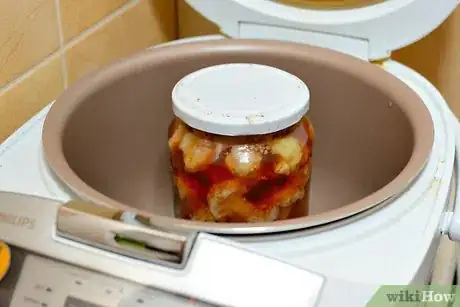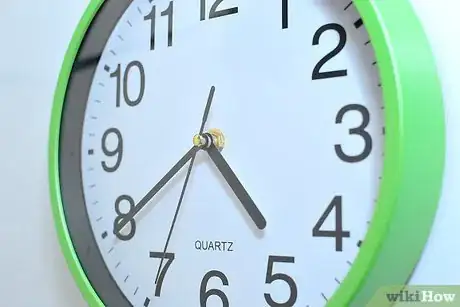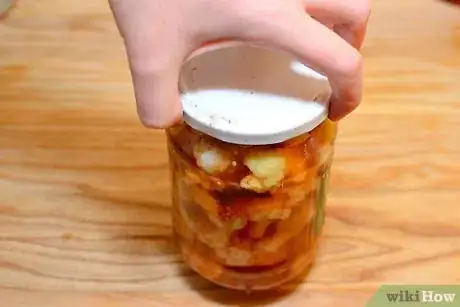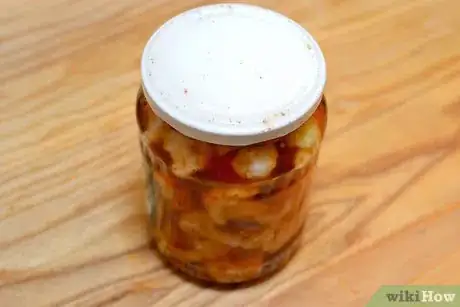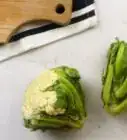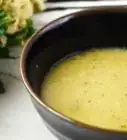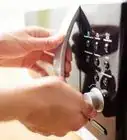X
wikiHow is a “wiki,” similar to Wikipedia, which means that many of our articles are co-written by multiple authors. To create this article, volunteer authors worked to edit and improve it over time.
This article has been viewed 35,902 times.
Learn more...
Pickled cauliflower can be enjoyed on its own as a healthy snack or served alongside a variety of meats and main dishes. The simplest way to make it is by letting the pickles develop in the refrigerator, but for longer-term storage, make the pickles using a boiling water canner.
Ingredients
Makes 1 qt (1 L) pickled cauliflower
- 1 qt (1 L) cauliflower florets
- 1 tsp (5 ml) mustard seed
- 1/2 tsp (2.5 ml) celery seed
- 2 cups (500 ml) white vinegar
- 1 cup (250 ml) granulated white sugar
- 2 to 3 garlic cloves, peeled
- 1 Tbsp (15 ml) kosher or pickling salt (or as needed)
- 1/2 tsp (2.5 ml) black peppercorns
- 1/2 tsp (2.5 ml) turmeric
- 1/4 tsp (1.25 ml) red pepper flakes (optional)
- 1 cup (250 ml) water (or as needed)
Steps
Before You Begin: Preparations
-
1Clean the cauliflower. Place the florets in a colander and thoroughly rinse them under cool running water. Allow the excess water to drain off the cauliflower before proceeding.
- You should also cut off any brown marks or undesirable blemishes using a sharp knife.
-
2Prepare the jars. Fill a stockpot halfway with water and boil the water over medium-high heat. Place the glass jars and lids you intend to use inside the boiling water to sanitize them.[1]
- You will need one quart (liter) jar, two to three pint (half-liter) jars, or four to five half-pint (quarter-liter) jars for this process.
- If you are canning the pickles instead of making refrigerator pickles, the canning jars you use will also have bands. Place the bands inside the boiling water, as well.
- Remove the lids from the water after 30 seconds and let them dry on a clean kitchen towel on the counter.
- Remove the jars and bands from the water after 10 minutes and let them air-dry on the same kitchen towel.
Advertisement
Method 1
Method 1 of 2:
Method One: Refrigerator Pickles
-
1Toast the seeds.[2] Place the mustard seed and celery seed in a medium saucepan and set the saucepan on the stove over medium heat. Toast the seeds for about 2 minutes, or until they are fragrant and lightly browned.
- Swirl the pan or stir the seeds continuously to prevent the seeds from burning.
- Toasting the seeds first draws out their natural flavor, thereby improving the taste of the dish overall.
-
2Add the vinegar and other seasonings. Pour the vinegar into the saucepan, followed by the sugar, garlic, salt, peppercorns, turmeric, red pepper flakes, and water. Continue heating the contents of the saucepan until they reach a boil.
- Once the solution reaches a boil, drop the heat to medium so that the solution simmers gently as you prepare the cauliflower florets. The solution needs to be hot when you add it, but it does not need to be at a rolling boil.
-
3Pack the cauliflower in a jar. Place the florets into a clean quart (liter) sized jar, packing them in as tightly as possible.
- Any size jar will work for this method: quart (liter), pint (half-liter), or half-pint (quarter-liter). The jars do not need to have bands, but they do need to have tight lids.
-
4Pour in the hot liquid. Pour the hot pickling solution over the cauliflower inside the jar. Make sure that the solution seeps all the way down to the bottom of the jar, and leave roughly 1/2 inch (1.25 ml) empty headspace at the top of each jar.
- The headspace will prevent the glass from cracking or breaking as the liquid expands and contracts.
-
5Let cool. Keep the jar on a counter or table until the solution drops down to room temperature. After the temperature drops, cover the jar securely with its lid.
- Do not place the jar directly in the refrigerator. The glass will be hot after you pour the hot liquid in, and a sudden shift in temperature can cause the glass to crack.
-
6Refrigerate for a few days. Place the jar inside your refrigerator and let the pickling solution do its work. The cauliflower should begin to absorb the flavors within a few hours, but for maximum flavor, leave the jar alone for two or three days.[3]
-
7Store in the refrigerator. Store the sealed jar of pickled cauliflower in your refrigerator, taking what you need whenever you need it. When prepared in this manner, pickled cauliflower can last anywhere from two weeks to three months.
Advertisement
Method 2
Method 2 of 2:
Method Two: Boiling Water Canning
-
1Boil salt water. Fill a large saucepan halfway with water. Bring it to a boil over high heat, then add 1 Tbsp (15 ml) canning salt to the water. Let it return to a boil before continuing.
- You could add the salt to the water before it boils, but doing so will cause the water to reach a boil more slowly.
- The salt will help draw out and enhance the natural flavor of the cauliflower.
-
2Blanch the cauliflower. Add the cauliflower florets to the rapidly boiling water. Let them cook for 3 minutes, then immediately remove the pan from the heat source.
- The cauliflower needs to soften slightly, but you do not want it to become completely tender.
-
3Drain and cool. Pour the contents of the saucepan through a colander to drain the hot water. Rinse the cauliflower under cold running water for 1 to 2 minutes to cool the florets and stop the cooking process.
- Alternatively, you can dump the drained cauliflower into a large bowl of ice water for 3 minutes to cool it down instead of rinsing it under cold running water. You will need to drain the ice water by pouring the contents of the bowl through a colander.
-
4Toast the seeds. Place the mustard seed and celery seed in a medium saucepan. Heat the spices over a medium setting on your stove, swirling the pan continuously, for about 2 minutes. The seeds should become fragrant and should start taking on a brown tint.
- Continuous stirring prevents the seeds from burning.
- If you're short on time, this part of the process can be skipped. This step draws flavor out of the seeds, though, making your pickled cauliflower tastier when done.
-
5Add the vinegar and other seasonings. Pour the vinegar and another 1 cup (250 ml) of water into the saucepan with your toasted seeds. Add the sugar, garlic, peppercorns, turmeric, red pepper flakes, and another 1 Tbsp (15 ml) pickling salt, as well. Bring the solution to a boil, then drop the temperature and let the solution simmer for 5 minutes.
-
6Pack the cauliflower in a jar. As the pickling solution simmers, tightly pack your cooled cauliflower florets into clean glass canning jars. Leave as little space as possible.
- For this method, it works best if you use half-pint (quarter-liter) or pint (half-liter) sized jars instead of full quart jars. The processing times provided here are for jars of this size.
-
7Pour in the pickling solution. Distribute the solution evenly into each jar of cauliflower. Make sure that the solution fills each jar to the very bottom, and leave at least 1/2 inch (1.25 cm) of empty headspace at the top of each jar.
- Wipe the rims of each jar with a hot, damp towel before covering the container with a lid. Fasten the lid in place by tightly screwing on a corresponding metal band.
- The headspace is necessary since the contents of the jar can expand during the canning process. If you do not have the headspace, the pressure inside the jar can actually cause the glass to break.
-
8Place the jars in your canner. Place the jars evenly along the bottom rack of a boiling-water canner. Pour enough water inside the cover the jars by 3 inches (7.6 cm) or more. Turn on the heat source.
- If you do not have an actual canner, place the jars inside a large stockpot fitted with a metal rack. Heat the stockpot on the stove over high heat.
-
9Process for 10 to 20 minutes. Start the clock once the water inside your canner has reached a boil. The process time will vary depending on your altitude.[4]
- For altitudes between 0 and 1000 feet (0 and 305 m), process the jars for 10 minutes.
- For altitudes between 1000 and 6000 feet (305 m and 1830 m), process the jars for 15 minutes.
- For altitudes above 6000 feet (1830 m), process the jars for 20 minutes.
-
10Let sit. Remove the jars with tongs or a special jar lifter, then place them on a kitchen towel spread over your counter or table. Allow the jars to cool and dry for six hours.
-
11Store at room temperature. Store the jars of pickled cauliflowers in a cool, dark place. When made in this manner, pickled cauliflowers should last for up to one year.
- Note that you will need to refrigerate these pickles after opening the jar.
Advertisement
Things You'll Need
Preparations
- Colander
- Kitchen knife
- Kitchen towel
- Stockpot
- Jar tongs
- Glass jars with lids and bands; 1 quart (liter), 2 to 3 pint (half-liter), or 4 to 5 half-pint (quarter-liter)
Refrigerator Pickles
- Medium saucepan
- Heat-resistant spatula
- Refrigerator
Boiling Water Canning
- Large saucepan
- Colander
- Medium saucepan
- Heat-resistant spatula (optional)
- Boiling water canner OR large stockpot with rack
- Jar tongs
- Kitchen towel
References
- ↑ http://www.saveur.com/article/Recipes/Pickled-Cauliflower
- ↑ http://www.recipegirl.com/2012/04/16/pickled-cauliflower/
- ↑ http://www.foodnetwork.com/recipes/ted-allen/refrigerator-pickles-cauliflower-carrots-cukes-you-name-it-recipe.html
- ↑ http://nchfp.uga.edu/how/can_06/pickled_cauliflower_brussel.html
About This Article
Advertisement
